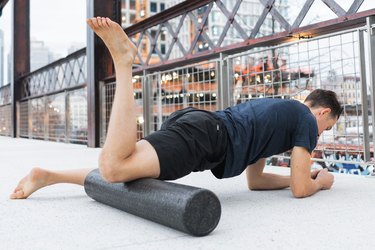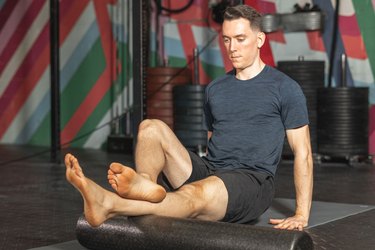
If you hate stretching, need a quick but effective workout warm-up or cooldown, have stiff muscles or joints or sit at a desk all day, foam rolling can seriously upgrade your life. In other words, just about everyone can benefit from foam rolling.
When you're ready to give it a try, this expert-backed guide is your one-stop-shop for all things foam rolling, from how the technique works, to which foam rollers to check out, to common mistakes you'll want to avoid.
Video of the Day
Video of the Day
What Foam Rolling Is All About
Foam rollers are cylinder-shaped pieces of high-density foam that range in size from 18 inches to three feet in length. (They're typically about six inches in diameter.) These days, you can buy them at sporting goods stores or on Amazon for anywhere between 10 and 40 bucks a pop.
You use these big cylinders to release your muscles and connective tissue called fascia by either lying down or rolling your body back and forth on the foam roller, explains Grayson Wickham, DPT, CSCS, founder of the mobility and flexibility platform Movement Vault.
In the science world, foam rolling is called "self-myofascial release." Basically, these tools allow you to give yourself a massage.
How Foam Rolling Benefits Your Body (and Mind)
Though many people think that foam rolling physically lengthens your muscles and connective tissue (and breaks up "knots"), that's not actually how this self-massage technique delivers its hurts-so-good results.
"The force needed to actually deform fascia or muscle would break the skin," says physical therapist Morgan Fielder, DPT.
Though foam rolling can decrease muscle tightness and tension, it does so by interacting with your nervous system, your brain, spinal cord and the nerves that branch off of it. "Foam rolling sends an impulse to your nervous system, which then sends an output to your muscle that helps it relax," Wickham explains.
That signal helps your nervous system shift from high-alert "fight-or-flight" mode, which creates tense muscles, to relaxed "rest-and-recover" mode.
Muscles feel tight when they've shortened, whether from spending too much time in poor posture (like hunching over your desk) or from an injury or intense workout. "The relaxation of your nervous system and muscle leads to an increase in muscle length and decrease in muscle tightness, which can last a few hours to a couple of days," Wickham says.
Foam rolling "also helps improve blood flow to specific regions, helping you prepare for — or cool down from — exercise," Fielder says. Plus, it just might help you tune into your body a bit more. "Foam rolling gets you out of your head, allowing you to be in the present moment," she says.
Here's what that can actually mean for your body:
- Greater mobility. "If you experience chronic tightness and reduced range of motion, you often have to 'trick' your nervous system into relaxing a bit — and foam rolling can help make that happen," Fielder says. In fact, a November 2015 review in the International Journal of Sports Physical Therapy found that foam rolling appears to effectively increase joint range of motion (without hurting performance) when used before and after exercise, although more research is needed.
- Improved athletic performance. The increase in blood flow and range of motion promoted by foam rolling can also help you perform better in the gym, Fielder says. A small 2014 study in the International Journal of Exercise Science, for example, found that a warm-up including full-body foam rolling improved fit men's performances in tests of power, speed, agility and strength.
- Faster injury recovery. Though Fielder doesn't recommend foam rolling fresh muscular injuries (like strains) that are still swollen, the practice can help minimize pain and sensitivity that may persist in the weeks and months after swelling dies down.
- Reduced muscle soreness. Increased blood flow means a greater influx of oxygen and nutrients, so foam rolling can also support muscle recovery and ward off muscle soreness, says Ronnie Sweiss, NESTA-certified personal trainer at Life Time Burr Ridge in Illinois. According to a small January 2015 study in the Journal of Athletic Training, foam rolling after intense exercise can reduce delayed-onset muscle soreness.
How to Get Started
Step 1: Buy a Foam Roller
First things first: You're going to need a piece of equipment. If you have access to a gym, chances are you'll find a few types of foam rollers there. But you can buy a high-quality foam roller all of your own to use at home for under $25.
Foam Rollers Experts Love
- Best for Beginners: SPRI High-Density Foam Roller ($21.62, Amazon). This standard cylinder is all you need for everyday rolling, Sweiss says.
- Best Textured Foam Roller: TriggerPoint Grid Foam Roller ($34.95, Amazon). A grid pattern, knobs or bumps up the intensity of the rolling experience.
- Best Splurge: Hyperice Vyper 2.0 High-Intensity Vibrating Fitness Roller ($199, Amazon). This super-dense roller increases the stimulation with vibration.
Step 2: Pick Your Focus Areas
Once you have a roller, figure out what muscles and areas you want to decrease tightness in, Wickham says. "Pick a muscle to target, and sit or lie down with that muscle on top of the foam roller, applying light pressure at first and increasing to moderate, but tolerable, pressure." (You can press your hands or feet into the group for support and to lighten the pressure.)
Start with areas you've previously injured or where you have limited mobility, since they tend to hold extra tension, Fielder adds.
Tip
Foam rolling should never be intensely painful. In fact, foam rolling too hard can trigger your nervous system’s threat response and make muscles tighten up more.
Apply steady pressure to that tight area for 30 to 60 seconds, or add in some movement by rolling up and down the length of the muscle in two- to four-inch increments, Wickham says.
If you're rolling out your hamstring, for example, you'd sit with your roller between your hamstring and the floor planting your hands at your sides and slightly behind you for balance. You'd roll up and down your leg between your knee and hip.
Step 3: Learn the Best Foam Rolling Exercises
There are a few parts of the body where many people experience tension and limited mobility (hello, tight hip flexors), so Wickham recommends starting with the following foam rolling exercises.
Move 1: Lat Release
- Lie on your side with your bottom arm extended overhead.
- Place the foam roller on the outside of your armpit, where your torso meets your upper arm, and rotate slightly so that your chest points slightly upward so that your back muscles — not the side of your ribs — are positioned on the roller.
- Roll in two- to four-inch increments, making your way down toward your lower rib cage.
- Continue rolling up and down for one minute.
- Repeat on the other side.
Move 2: Hip Flexor and Quad Release
- Get into forearm plank position.
- Place a foam roller between the front of your upper leg and the floor, about two inches above your knee.
- Keeping the knee of your targeted leg bent, roll up and down the front of your thigh in two- to four-inch increments, making your way up to the front of your hip bone.
- Continue rolling up and down for one to two minutes.
- Repeat on the other leg.
Move 3: Calf Release
- Sit with your arms straight at your sides and hands pressing into the floor.
- Place a foam roller between the bottom of your lower leg and the floor.
- Starting about two inches above the back of your ankle, slowly roll up and down in two- to four-inch increments, working your way up to just below your knee.
- Continue rolling up and down for one minute.
- Repeat on the other leg.
The Best Time to Foam Roll
There are two ideal times to roll out: before and after a workout. To use foam rolling in a warm-up, Fielder recommends spending two to three minutes rolling out the muscle groups you're going to use in your upcoming sweat session. To use it in a cooldown, foam roll for four to five minutes to give your body ample time to relax.
"To increase foam rolling's effectiveness and help make its results last, always follow it up with some type of stretching," Wickham says. Before a workout, you might opt for dynamic stretching, while after a workout (or before bed), you might stick with relaxing, stationary (called static) stretching.
Foam Rolling Concerns to Keep in Mind
To ensure foam rolling does your body good, keep a few important guidelines in mind.
- Get the green light. Talk to a health care provider — like a physical therapist or your primary care physician — before you start foam rolling if you have fibromyalgia, advanced osteoporosis, bone fractures or any active infections, Fielder says, since this type of pressure may worsen these conditions.
- Avoid your joints. Don't roll directly over joints or other bony areas, like your knees or rib cage, Sweiss says. Applying this kind of pressure to your joints — and areas that have little protection from muscle or other tissue — could be painful and leave you bruised.
- Protect your lower back. Sweiss recommends avoiding foam rolling your lower back — especially if you have existing issues in the area. "Your lower back contains a lot of nerve endings, which can be easily overstimulated by foam rolling," he says. "Plus, applying direct pressure to your lower back can cause you to over-arch or hyperextend it, which can exacerbate existing issues and pain."
- Know when to stop. Ease off the foam rolling if you experience any numbness, tingling and/or burning pain. "This indicates you could be aggravating a nerve," Wickham says. Switch to another area of the body and check in with a physician or physical therapist if the sensations persist.
- International Journal of Sports Physical Therapy: "The Effects of Self-Myofascial Release Using a Foam Roll or Roller Massager on Joint Range of Motion, Muscle Recovery, and Performance: A Systematic Review"
- International Journal of Exercise Science: "An Acute Bout of Self-Myofascial Release in the Form of Foam Rolling Improves Performance Testing"
- Journal of Athletic Training: Foam Rolling for Delayed-Onset Muscle Soreness and Recovery of Dynamic Performance Measures


